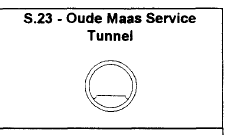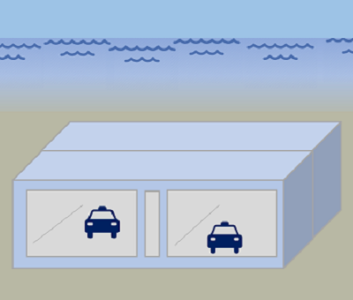Oude Maas Service Tunnel
HEIGHT: 4.65 m OD (4.0 m ID)
WIDTH: (circular)
DEPTH AT BOTTOM OF STRUCTURE: 3 m below the existing canal bottom.
TOTAL IMMERSED LENGTH: 481 m
ENVIRONMENTAL CONDITIONS:
Busy shipping channel.
FABRICATION METHOD:
Vertical casting. Assembly of all elements in a single
dewatered basin. Match casting was not used. Instead a
joint of 1-5 cm was made using interior and exterior
forms and rubber packers in the cable ducts. These
joints were injected with epoxy resin. The elements were
then post-tensioned. Ballast concrete was added in bottom.
WIDTH: (circular)
DEPTH AT BOTTOM OF STRUCTURE: 3 m below the existing canal bottom.
TOTAL IMMERSED LENGTH: 481 m
ENVIRONMENTAL CONDITIONS:
Busy shipping channel.
FABRICATION METHOD:
Vertical casting. Assembly of all elements in a single
dewatered basin. Match casting was not used. Instead a
joint of 1-5 cm was made using interior and exterior
forms and rubber packers in the cable ducts. These
joints were injected with epoxy resin. The elements were
then post-tensioned. Ballast concrete was added in bottom.
Heinenoord,
Netherlands

Rijkswaterstaat
Koninklijke Nederhorst Bouw B.V., Dirk Verstoep Nederland B.V.
Rijkswaterstaat
60m
481m
3m
Project construction
1975-04-30
8
One tube
4.65m
circular
10 verticaUy cast 6 m long cylindrical segments form the 60 m long elements. The first
section was immersed against the abutment on the south bank. The abutment on the
north bank consists in a vertical circular shaft with a hexagonal box on top of it. A 4 m
hole is provided at the bottom to accommodate the end of the terminal tube. Similar in
! design and construction to the service tunnel under the Hollandsch Diep.
section was immersed against the abutment on the south bank. The abutment on the
north bank consists in a vertical circular shaft with a hexagonal box on top of it. A 4 m
hole is provided at the bottom to accommodate the end of the terminal tube. Similar in
! design and construction to the service tunnel under the Hollandsch Diep.
Vertical casting. Assembly of all elements in a single
dewatered basin. Match casting was not used. Instead a
joint of 1-5 cm was made using interior and exterior
forms and rubber packers in the cable ducts. These
joints were injected with epoxy resin. The elements were
then post-tensioned. Ballast concrete was added in bottom.
dewatered basin. Match casting was not used. Instead a
joint of 1-5 cm was made using interior and exterior
forms and rubber packers in the cable ducts. These
joints were injected with epoxy resin. The elements were
then post-tensioned. Ballast concrete was added in bottom.
Dished steel bulkheads
with watertight manholes
ware installed. 0.5 Bar
pressure test was made.
Leaks were sealed by injection.
with watertight manholes
ware installed. 0.5 Bar
pressure test was made.
Leaks were sealed by injection.
Busy shipping channel.
Transport to site was by catamaran barge, Placement was made from two accurately
positioned spudded barges. Inboard end rested on cantilever beams and outboard end
on adjustable jacks.
positioned spudded barges. Inboard end rested on cantilever beams and outboard end
on adjustable jacks.
Gina and Omega joint
protected with flexible internal
steel closure plate.
protected with flexible internal
steel closure plate.
High density concrete 0,325 m thick was adequate. No external waterproofing membrane
was used. Pressure test prior to flotation also added to security against leakage.
was used. Pressure test prior to flotation also added to security against leakage.
A jetted sand foundation was installed. The first stage was up to about a meter above
the bottom of the tunnel. Then the jacks were removed. Sandjetting was then continued
to the top of the tunnel after which hopper barges completed the cover.
the bottom of the tunnel. Then the jacks were removed. Sandjetting was then continued
to the top of the tunnel after which hopper barges completed the cover.
Approximately three meters of ordinary backfill.

